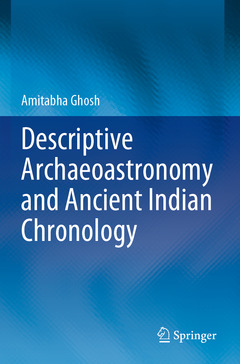Descriptive Archaeoastronomy and Ancient Indian Chronology, 1st ed. 2020
Auteur : Ghosh Amitabha

This book presents the basic fundamentals of descriptive archaeoastronomy and its application to the astronomical descriptions found in ancient Indian scriptures. Archaeoastronomy is a branch of positional astronomy that helps to determine the epochs of ancient astronomical alignments and special astronomical events. In this book, only the descriptions of special stellar alignments and events found in ancient texts can identify the antiquity of the descriptions. India possesses a large volume of ancient scriptures like Vedas and Puranas which contain many astronomical descriptions as in ancient India positional astronomy was well developed. The antiquities of these texts are determined through archaeoastronomical techniques. Major events like Mahabharata War are dated and using these dates a chronology of ancient India is determined. The astronomically determined chronology is compared with the results from various archaeological, palaeoclimatological, geological and genealogical investigations of ancient India. This introductory book interests readers interested in unveiling the mystery involved with the protohistory of this ancient civilization.
Table of Contents
Chapter 1: INTRODUCTION
1.1: Preamble
1.2: Importance of Chronology in History1.3: Problems with Establishing Ancient Indian Chronology
1.4: Application of Astronomical Technique
1.5: Influence of Astronomy in Society
1.6: Structure of Ancient Indian Chronology and its Self consistency
Chapter 2: RUDIMENTS OF POSITIONAL ASTRONOMY AND ARCHAEOASTRONOMY
2.1: Introduction to Positional Astronomy
2.1.1: A few basic points
2.1.2: Celestial coordinates
2.2: Variations of Astronomical Parameters
2.2.1: Periodic variations
2.2.2: Secular changes
2.3: Eclipse
2.4: Physical and Descriptive Archaeoastronomy
2.4.1: Physical archaeoastronomy
2.4.2: Basics of descriptive archaeoastronomy
Chapter 3: ASTRONOMY IN ANCIENT INDIA
3.1: Importance of Understanding the Ancient Indian Astronomical System
3.2: Rediscovery of Ancient Indian Astronomy
3.3: Astronomy in Ancient India
3.3.1: Presiddhāntic astronomy
3.3.2: Siddhāntic astronomy
Chapter 4: DESCRIPTIVE ARCHAEOASTRONOMICAL APPROACHES
4.1: Introduction
4.2: Effects of the Precession of Equinox on Observational Astronomy
4.2.1: Changing relation of seasons with lunar months4.2.2: Simultaneous transit of important stars
4.2.3: Heliacal rising of stars and constellations
4.3: Exaltation of Planets
4.4: Ancient Eclipses
4.5: Advance of Perihelion of Earth’s Orbit
4.6: Saptarshi Cycle
Chapter 5: ARCHAEOASTRONOMICAL STUDY OF ANCIENT INDIAN CHRONOLOGY: DATING MAHĀBHĀRATA
5.1: Introductory Comments
5.2: Ancient India’s Geographic Boundaries as Implied in Ancient Texts
5.3: Structural Frame Work for Ancient Indian Chronology
5.4: Genealogy of Purānic Dynasties
5.5: Date of Mahābhārata
5.5.1: Types of astronomical references
5.5.2: Dating Mahābhārata war
Chapter 6: CHRONOLOGY OF VEDIC AND VEDĀNGA PERIODS
6.1: Introduction
6.2: Hints of High Antiquity of Vedas
6.3: Astronomical References in Vedic and Other Ancient Texts
6.3.1: Heliacal rising of Ashvins at winter solstice
6.3.2: Madhu vidyāand heliacal rising of Ashvins
6.3.3: Orion’s head near vernal equinox
6.3.4: Heliacal rising of Maghā (α Leonis) on summer solstice day6.3.5: Dogs of Yama and the direction to pitriloka
6.3.6: Prajāpati – Rohini legend
6.3.7: Solar eclipse recorded in Rigveda
6.4: Astronomical References in Brāhmanas
6.4.1: Krittikā never swerves from the east6.4.2: Solar eclipses and heliacal risings described in Brāhmanas
6.5: Vedānga Jyotishā
6.6: Dating through Astrological References
6.7: The Emerging Picture
Chapter 7: ARCHAEOLOGICAL, GEOLOGICAL AND GENEALOGICAL INDICATIONS OF ANCIENT CHRONOLOGY
7.1: Consistency of Astronomical Dating
7.2: Lost River Sarasvati
7.3: Changing Sea Level7.4: Genealogical Sources for Investigating Ancient Indian Chronology
7.5: Archaeological Discoveries and Ancient Indian Chronology
CONCLUDING REMARKS
BIBLIOGRAPHY
Appendix A: SPHERICAL ASTRONOMY
A.1: Celestial Sphere and Spherical Trigonometry
A.2: Transformation of Coordinates
A.3: Rising and Setting of Celestial Objects
A.4: Effect of Precession of the Equinox
A.5: Heliacal Rising of a Star
Appendix B: NIRAYANA LONGITUDES OF NAKSHATRAS AND ZODIACAL SIGNS
Appendix C: GENEALOGICAL LISTS OF ANCIENT INDIAN KINGS
C.1: Predeluvial DynastiesC.2: Postdeluvial Solar Dynasty of Ikshāku
C.3: Lunar Dynasty: Main Line of Purus
C.4: Line of Yadu DynastyC.5: Post Mahābhārata Dynasties
INDEX
Amitabha Ghosh received his Bachelor’s, Master’s and Doctoral degrees in Mechanical Engineering from Calcutta University in 1962, 1964 and 1969, respectively. After serving as a Lecturer in Mechanical Engineering at his alma mater, Bengal Engineering College, Shibpur (now an Institute of National Importance—Indian Institute of Engineering Science and Technology, Shibpur) from 1965 to 1970, Prof. Ghosh joined Indian Institute of Technology Kanpur as an Assistant Professor in January 1971. He served at the Institute as a Professor of Mechanical Engineering from 1975 until his retirement in 2006.
From 1977 to 1978, Professor Ghosh visited the RWTH Aachen as a Senior Fellow of the Alexander von Humboldt Foundation, and subsequently visited the RWTH Aachen in the same capacity several times between then and 2012. He served as Director of the Indian Institute of Technology Kharagpur from 1997 to 2002. His primary areas of research are manufacturing science, robotics, kinematics and mechanism theory and dynamics of mechanical systems. Prof. Ghosh has received many academic awards including a number of Calcutta University Gold Medals, the D.Sc. (h.c.), Distinguished Teacher award from IIT Kanpur and the Award for Excellence in Research by the National Academy of Engineering.
Broadens your understanding of archeoastronomy
Maximizes reader insights into descriptive archeoastronomy and its applications
Enriches understanding of mystery involved with the protohistory of our ancient civilization
Date de parution : 07-2021
Ouvrage de 198 p.
15.5x23.5 cm
Date de parution : 07-2020
Ouvrage de 198 p.
15.5x23.5 cm



